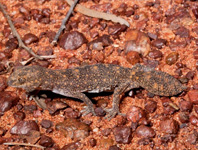Abstract
We describe a new species of small terrestrial gecko in the genus Diplodactylus from inland regions of western Queensland and New South Wales, Australia. Diplodactylus ameyi sp. nov. can be distinguished from its congeners in the Diplodactylus conspicillatus species-group by its relatively large size, bulbous tail which lacks an acute attenuated extension at tip, small first labial scale and comparatively robust head morphology (which includes a broadly rounded snout and no well-defined canthus rostralis). Related populations from eastern and central Queensland currently referred to D. platyurus include further deeply divergent lineages but additional material is required to resolve systematic boundaries in this region.
References
Cogger, H.G. (2014) Reptiles and Amphibians of Australia. 7th Edition. CSIRO Publishing, Collingwood, Victoria, 1033 pp.
Dell, J. & Chapman, A. (1978) Reptiles and frogs of the Durokoppin and Kodj Kodjin Nature Reserves. Records of the Western Australian Museum, 7 (Supplement), 69–74.
Doughty, P., Oliver, P.M. & Adams, M. (2008) Systematics of stone geckos in the genus Diplodactylus (Reptilia: Diplodactylidae) from northwestern Australia, with a description of a new species from the Northwest Cape, Western Australia. Records of the Western Australian Museum, 24, 247–265.
Doughty, P. & Oliver, P.M. (2013) Systematic of Diplodactylus (Squamata: Diplodactylidae) from the south-western Australian biodiversity hotspot: redefinition of D. polyophthalmus and the description of two new species. Records of the Western Australian Museum, 28, 44–65.
Doughty, P., Pepper, M. & Keogh, J.S. (2010) Morphological and molecular assessment of the Diplodactylus savagei species complex in the Pilbara region, Western Australia, with a description of a new species. Zootaxa, 2393, 33–45.
Greer, A.E. (1989) The Biology and Evolution of Australian Lizards. Surrey Beatty & Sons Ltd, Sydney, 264 pp.
Hutchinson, M.N., Doughty, P. & Oliver, P.M. (2009) Taxonomic revision of the stone geckos (Squamata: Diplodactylidae: Diplodactylus) of southern Australia. Zootaxa, 2167, 25–46.
Kluge, A.G. (1967) Systematics, phylogeny and zoogeography of the lizard genus Diplodactylus Gray (Gekkonidae). Australian Journal of Zoology, 15, 1007–1108.
http://dx.doi.org/10.1071/ZO9671007Longman, H.A. (1915) Reptiles from Queensland and the Northern Territory. Memoirs of the Queensland Museum, 3, 30–34.
Lucas, A.H.S. & Frost, C. (1897) Descriptions of two new species of lizards from central Australia. Proceedings of the Royal Society of Victoria, 9, 54–56.
Oliver, P.M., Cooper, S.J.B. & Hutchinson, M. (2007) Phylogenetic relationships in the lizard genus Diplodactylus Gray and resurrection of Lucasium Wermuth (Gekkota, Diplodactylidae). Australian Journal of Zoology, B 276, 2001–2007.
http://dx.doi.org/10.1071/zo07008Oliver, P.M., Adams, A., Lee, M.S.Y., Hutchinson, M.N. & Doughty, P. (2009) Cryptic diversity in vertebrates: molecular double estimates of species diversity in a radiation of Australian lizards (Diplodactylus, Gekkota). Proceedings of the Royal Society, B 276, 2001–2007.
http://dx.doi.org/10.1098/rspb.2008.1881Oliver, P.M., Couper, P.J. & Pepper, M. (2014) Independent transitions between monsoonal and arid biomes revealed by systematic revision of a complex of Australian Geckos (Diplodactylus; Diplodactylidae). PLoS ONE, 9 (12), e111895.
http://dx.doi.org/10.1371/journal.pone.0111895Parker, H.W. (1926) New reptiles and a new frog from Queensland. Annals and Magazine of Natural History, Series 9, 17, 665–670.
http://dx.doi.org/10.1080/00222932608633465Pianka, E.R. & Pianka, H.D. (1976) Comparative ecology of twelve species of nocturnal lizards (Gekkonidae) in the Western Australian desert. Copeia, 1976 (1), 125–142.
Sternfield, R. (1924) Beiträge zur Herpetologie Inner-Australiens. Abhandlungen der Senckenbergischen Naturforschenden Gesellschaft, 38, 221–251.
Storr, G.M., Smith, L.A. & Johnstone, R.E. (1990) Lizards of Western Australia III. Geckos and Pygopods. Western Australian Museum, Perth, 141 pp.

